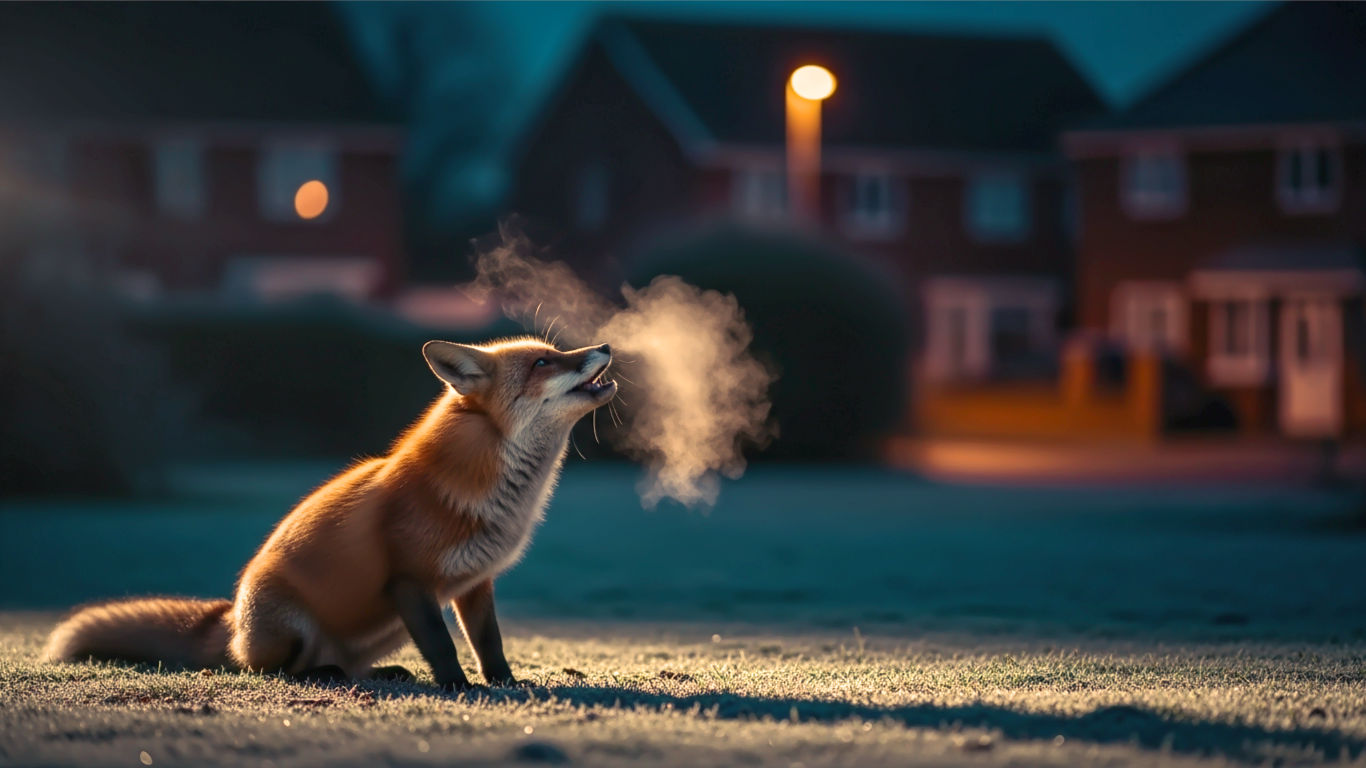The Diverse Vocalisations of Foxes: What Noises Do They Make?
Discover the secret language of Britain’s foxes. This ultimate guide explains every sound they make, from the vixen’s scream to cubs’ yelps.

This post may contain affiliate links. If you make a purchase through these links, we may earn a commission at no additional cost to you.
It’s a sound that can make the hairs on your arms stand up. A sudden, sharp, blood-curdling scream rips through the quiet of a suburban night. It sounds painful, desperate, and terrifyingly human. If you’ve ever been jolted awake by it, your first thought probably wasn’t about wildlife. But the culprit is almost certainly your shy, bushy-tailed neighbour: the red fox.
For centuries, foxes have trotted through our countryside and, more recently, our towns and cities, often seen but rarely understood. We think of them as silent, cunning creatures, slipping through the shadows. The truth is, they’re incredible communicators with a surprisingly complex and varied language. That infamous scream is just one small part of a rich vocal toolkit they use to navigate their social lives, defend their territory, and raise their families.
Most of us only ever hear the most dramatic calls, leading to all sorts of myths—most commonly, that the scream is the sound of a fox being attacked or killed. But it’s usually nothing of the sort. In fact, it’s often the sound of fox romance.
This guide is here to unravel the mystery behind the noises you hear from your back garden. We’ll become fox translators, decoding every bark, whimper, and chatter. By the end, you’ll not only understand what that midnight scream really means, but you’ll also have a new appreciation for the complex conversations happening all around you, right under your nose.
The Fox’s Toolkit: A Dictionary of Common Calls
A fox’s world is full of sound. They have a range of at least 20 distinct calls, but most of what you’ll hear in Britain can be boiled down to a few key vocalisations. Think of this as your essential fox-to-English dictionary.
The Bark: More Than Just a “Woof”
When we think of barking, we think of dogs. A fox’s bark is quite different. It’s not the deep, repetitive ‘woof-woof’ of a Labrador, but a sharper, higher-pitched, and often more frantic sound.
A simple explanation: The bark is the fox’s main way of saying, “I’m over here!” or “Watch out!” It’s their go-to call for long-distance communication and raising the alarm.
A detailed explanation: The most common fox bark is a sequence of three to five syllables, often called the “wow-wow-wow” bark. It’s an explosive, sharp sound that can carry a surprisingly long way on a clear night. Its main job is as a contact call. Imagine two foxes foraging separately in a large territory; they use this bark to keep track of each other’s location without needing to be in sight. It’s a bit like a human shouting, “Marco!” and waiting for a “Polo!” in return.
However, the bark isn’t a one-trick pony. A single, sharp alarm bark is a very different message. This is a sudden, harsh yap that signals immediate danger—perhaps a badger getting too close to the den, or a human with a torch startling them. If you hear this, you can be sure the fox has spotted something it doesn’t like. The tone and intensity can change, too. A young fox’s bark might sound yappier and less confident than the hoarse, authoritative bark of a large, dominant dog fox.
The Vixen’s Scream: The Sound That Haunts the Night
This is the big one. The sound that sends shivers down spines and prompts worried calls to the RSPCA. It’s a piercing, drawn-out shriek that can sound unnervingly like a person in terrible distress.
A simple explanation: This scary-sounding scream is usually made by a female fox (a vixen) during the mating season. She’s not hurt; she’s calling for a mate.
A detailed explanation: Known as the contact scream or mating call, this vocalisation is most common during the peak of the breeding season, from December to February. It’s a highly emotional, intense sound, and its primary purpose is advertising. A vixen will let out this incredible shriek to signal to the local dog foxes that she is ready to mate. It’s her way of saying, “I’m here, and I’m available!” The scream also serves as a stark warning to other rival vixens, telling them to stay away from her patch.
While it’s most closely associated with vixens, dog foxes can make a similar, though often hoarser and less piercing, sound in response. It’s the sound of fox courtship, a dramatic opera playing out in our gardens and fields. Though it’s most frequent in winter, you can hear it at other times of the year, sometimes during territorial disputes. But if you’re hearing it on a cold January night, it’s almost certainly about romance, not violence.
Gekkering: The Fox’s Argument
This is perhaps the strangest sound a fox makes. It’s not a bark or a scream, but a guttural, rapid-fire chattering or rattling noise. It sounds a bit like a rattlesnake mixed with a wooden football rattle.
A simple explanation: Gekkering is the sound of a fox fight. You’ll hear it when they’re having an argument, either seriously or in play.
A detailed explanation: Gekkering (sometimes called ‘clicketing’) is a series of low, throaty staccato sounds made deep in the chest. It’s the definitive sound of fox conflict. You’ll hear it most often during aggressive encounters between two adult foxes, perhaps when one strays into another’s territory. It’s all part of the ritual of establishing dominance without having to get into a really serious, wounding fight. They’ll posture, circle each other, and gekker furiously.
You’ll also hear it from a very different source: fox cubs. As they grow, their play becomes rougher and more serious. They’ll chase, pounce, and tumble over each other, all while gekkering excitedly. For them, it’s practice for the real-world disputes they’ll face as adults. So, whether it’s a serious adult confrontation or a playful sibling squabble, gekkering is the unmistakable soundtrack to a fox getting its point across in no uncertain terms.
The Whimper and Whine: Sounds of Submission and Care
Not all fox sounds are loud and aggressive. They have a softer, more intimate side to their language, reserved for close-quarters communication with family.
A simple explanation: These are quiet, gentle noises used by cubs to get attention, or by one fox to show another that it knows who’s boss.
A detailed explanation: Whimpers and whines are high-pitched, often quiet sounds that signal subordination and appeasement. A younger, less dominant fox will approach a more dominant one with its body held low, whining softly to show it means no harm. It’s the fox equivalent of saying, “Please don’t hurt me, you’re in charge.”
These sounds are also a huge part of family life. Fox cubs whine constantly to get their mother’s attention, to beg for food when she returns from a hunt, or to signal when they are cold or distressed. The vixen, in turn, will use soft murmurs and whines to soothe her cubs and call them to her. These are the gentle, nurturing sounds of the fox den, a world away from the dramatic screams of the mating season.
The Cub’s Playful Yelps and Murmurs
As spring turns to summer, a new set of sounds enters the fox’s repertoire: the noises of the nursery.
A simple explanation: These are the happy, excited noises of baby foxes playing and exploring the world for the first time.
A detailed explanation: When fox cubs first emerge from their den (the ‘earth’), they are full of energy and curiosity. Their vocalisations are undeveloped versions of the adult calls. They let out little playful yelps and tiny, hiccup-like barks as they chase and pounce on their siblings. These are not serious calls; they are the sounds of pure play and learning. You’ll also hear them making soft murmuring sounds as they explore their surroundings. Listening to these gentle, joyful sounds on a warm summer evening is one of the real treats for a patient British wildlife watcher.
A Year in a Fox’s Voice: The Seasonal Soundscape
A fox’s language isn’t static; it changes dramatically with the seasons. Their calls are tied to the annual cycle of mating, birth, growth, and dispersal. If you know what to listen for, you can tell what time of year it is just by the sounds the local foxes are making.
Winter (December – February): The Mating Season’s Opera
Winter is the noisiest time in the fox calendar. This is the peak of the breeding season, and the nights are filled with sound. The air is dominated by the two main courtship calls: the sharp, triple “wow-wow-wow” bark of a dog fox, trying to locate a vixen, and the vixen’s piercing scream in reply. It’s a conversation held across entire territories. The purpose is to find a partner and warn off rivals, and the urgency is palpable. Gekkering may also be more frequent as tensions run high and males compete for females.
Spring (March – May): The Quiet of the Nursery
After the drama of winter, spring brings a period of relative calm. Vixens give birth to their cubs in the safety of an underground earth. During this time, the adult foxes become much more secretive and quiet to avoid attracting attention to their vulnerable newborns. The loud territorial and mating calls fade away. The only sounds are the incredibly soft, intimate whimpers and murmurs between the vixen and her cubs, completely inaudible unless you were right next to the den. For the casual listener, it might seem as if the foxes have vanished.
Summer (June – August): The Cubs Find Their Voice
By early summer, the cubs are big enough to leave the den and start exploring the world above ground. This is when the fox soundscape changes again. The nights are now filled with the sounds of play. You’ll hear the cubs’ excited yelps, playful barks, and practice gekkering as they tumble and fight with their siblings near the den. The adult foxes will use quiet contact calls and whines to keep the family together. It’s a time of joyful, chaotic noise as the next generation learns the ropes.
Autumn (September – November): Voices of Dispersal
As summer ends, the cubs are nearly fully grown. Now, the family group begins to break up in a process called dispersal. The young foxes, particularly the males, are encouraged to leave and find territories of their own. This can be a time of renewed vocal activity. You’ll hear more barking as these young adults explore new areas and start to establish their own boundaries. It’s a period of social reshuffling, and the barks you hear are the sounds of a new generation staking their claim on the landscape.
What Are They Actually Saying? Decoding the Meaning
Understanding the individual calls is one thing, but the real magic is in understanding the context. A bark isn’t just a bark; its meaning changes depending on the situation.
“I’m Here!”: The Contact Call
The most common message sent between foxes is simply about location. The triple bark is the classic example. A fox isn’t shouting this into the void for no reason; it’s expecting a reply. It’s a vital tool for staying connected in a world where sight isn’t always reliable, especially at night. It helps mated pairs coordinate their hunting efforts and lets family members know where everyone is.
“Get Off My Lawn!”: Territorial Warnings
Foxes are highly territorial, especially in urban areas where patches can be small and fiercely defended. Sound is a brilliant way to mark your territory without risking a physical fight. A dominant fox will patrol its boundaries, letting out powerful barks to announce its presence. Think of it as an invisible fence made of sound. If another fox dares to cross the line, the barks might escalate into aggressive gekkering, a clear signal to back off immediately.
“Look Out!”: Alarms and Threats
The fox’s sharp, single alarm bark is an unmistakable warning. It’s directed at a specific threat and serves to alert any other foxes in the area, particularly cubs, that there’s danger afoot. The message is simple and effective: “Danger! Be alert! Hide!” It’s a selfless call, as the barking fox draws attention to itself to protect its family.
“Hello, Mum!”: Family Communication
Within the close-knit family unit, communication is much more subtle and nuanced. The soft whines and whimpers of cubs are designed to elicit a parental response—feeding, warmth, or grooming. When a subordinate fox whines at a dominant one, it’s a crucial social signal that maintains peace and order within the group. It’s the glue that holds the family hierarchy together, a constant, quiet conversation of respect and care.
Town Fox, Country Fox: Do Their Accents Differ?
With more than half of Britain’s foxes now living in towns and cities, it’s natural to wonder if their environment has changed their language. Do urban foxes have a different ‘accent’ to their country cousins?
While there’s no evidence of regional accents in the way humans have them, the urban environment almost certainly affects how and when foxes vocalise. Cities are noisy places. To be heard over the drone of traffic and other urban sounds, foxes might have to call louder or more often. Some studies suggest that urban animals in general often have to adjust the pitch of their calls to cut through low-frequency background noise.
Furthermore, urban territories are much smaller and more densely packed. This means a fox is far more likely to have a run-in with a neighbour, potentially leading to more frequent territorial barking and gekkering. They live a more compressed, intense social life than their rural counterparts, and their vocalisations likely reflect that. The constant presence of people and pets might also lead to more frequent alarm barks. So, while the language is the same, a town fox might just be a bit chattier—and louder—than a fox from the quiet countryside.
Who’s That Screaming? Ruling Out the Usual Suspects
The vixen’s scream is so dramatic that it’s often mistaken for other things. But Britain’s night is full of strange sounds, and it’s easy to point the finger at the fox when another creature is to blame. Here are some of the other common culprits for spooky nighttime noises:
- Tawny Owls: The classic “twit-twoo” is actually a conversation between a male and a female. But they also make a sharp, eerie “kee-wick” sound that can be very unsettling.
- Badgers: When badgers fight, they can let out some truly terrifying screams. Their calls are often deeper, more guttural, and more pig-like than a fox’s, but at a distance, it can be hard to tell.
- Peacocks: Surprisingly common in some rural and even suburban areas, a peacock’s call is a loud, descending cry that sounds a bit like a wailing cat.
- Muntjac Deer: This small, invasive deer species has a surprisingly loud, repetitive bark that is often mistaken for a dog or a fox. It’s a very common sound in woodland and large gardens, especially in the south of England.
- Domestic Cats: When two cats square up for a fight or are mating, the yowling, screeching, and hissing can be just as loud and unnerving as any fox.
The Fox in British Culture: From Cunning Trickster to Noisy Neighbour
Foxes occupy a unique place in the British imagination. In folklore, they are Reynard, the clever, cunning trickster who outwits his more powerful rivals. For centuries, they were associated with the controversial tradition of the fox hunt, a symbol of the rural class divide.
Today, their story is increasingly an urban one. For many, the fox is no longer a distant character from a Beatrix Potter book but a very real, and sometimes very loud, neighbour. The nightly chorus of barks and screams can be a source of annoyance, leading to complaints and a desire to see them removed.
Yet for many others, hearing those sounds is a magical reminder that true wilderness can thrive right in the heart of our bustling cities. They are a connection to the wild, a sign that our urban ecosystems are healthy enough to support such an intelligent and adaptable predator. They force us to ask questions about how we share our space with wildlife and whether we can learn to live alongside our noisy, fascinating, and furry neighbours.
A Fox Watcher’s Guide: How to Listen and What to Do
Once you start listening for them, you’ll realise the night is full of fox conversations. If you want to become a better fox listener, here are a few tips:
- When to Listen: The best time is at dusk or dawn, or in the dead of night when background noise is at a minimum. Winter is prime time for the dramatic mating calls, while summer is best for hearing the gentle sounds of cubs.
- What to Listen For: Don’t just listen for screams. Tune your ear to the sharp “wow-wow-wow” bark. It’s the most common call and a sure sign that foxes are nearby.
- What If a Fox Sounds Hurt? Nine times out of ten, that terrifying scream is a perfectly healthy vixen looking for a mate. A fox in genuine, severe distress is more likely to be silent to avoid attracting predators. However, if you see a fox that is obviously injured (e.g., a severe limp, dragging a leg) or sick (e.g., appearing disoriented or unnaturally tame in daylight), then it’s time to call for help. Contact your local wildlife rescue or the RSPCA for advice. Don’t approach the fox yourself.
Conclusion: The Rich and Complex Conversation of the Fox
The language of the fox is so much more than a single, scary scream in the night. It’s a rich, nuanced, and complex system of communication that governs every aspect of their lives. It’s a language of love, of war, of family, and of survival.
Each bark that echoes across a frosty field tells a story of territory and identity. Each whimper in the darkness of a den speaks of care and dependence. And yes, each scream that pierces the suburban silence tells a dramatic tale of courtship and competition.
So next time you’re woken by that wild cry, don’t pull the pillow over your head. Listen. You are not hearing a sound of pain or terror. You are hearing the sound of life. You are being given a brief, privileged insight into the secret social world of one of Britain’s most intelligent, adaptable, and misunderstood wild animals. The conversation is happening all around you. All you have to do is learn how to hear it.
Further Reading
For those interested in learning more about the behaviour and conservation of the red fox in the UK, these resources are highly recommended:
- The Wildlife Trusts: An excellent source of information on British wildlife, including detailed profiles on foxes. https://www.wildlifetrusts.org/wildlife-explorer/mammals/red-fox
- The Fox Project: A dedicated charity providing information, rescue services, and advice on living with foxes. https://foxproject.org.uk/
- The Vincent Wildlife Trust: A charity specialising in British mammal conservation, with extensive research on species like the fox. https://www.vwt.org.uk/
- Discovering Mammals (Mammal Society): Provides scientific information and distribution maps for UK mammals. https://mammal.org.uk/british-mammals/red-fox






